Pick of the Brown Bag
August 29, 2018
by
Ray Tate
Welcome to the Pick of the Brown Bag, a review of the current week’s comic books. In this posting I analyze a dynamic duet of Batgirl, the Annuals for Daredevil, Nightwing and Red Hood and the Outlaws. The latest installments of Red Sonja and X-23, Gossamer and Harley Quinn and two new books from Aftershock and IDW. If you haven’t the time to absorb the meatier critiques, never fear tweets can be found here: #PickoftheBrownBag.
Beyonders introduces Fortean hobbyist Jacob Tate. Forteans assess the yet to be explained. Whereas science advanced to expound on original Forteana like rains of frogs, singing stones and mysterious beasts, modern Forteans delve into the The Voynich Manuscript—an encrypted botany book—and the enigmatic airships documented in the past.
The Fortean Times is quite well-researched and often unearths rare history and hoaxes while still keeping an open mind about ghosts and UFOS. It’s the skeptic’s enquirer.
Bearing that in mind, Paul Tobin mixes fact and fiction. Perhaps he wants the reader to look up the truth herself.
These flights of fancy are the most interesting thing about Beyonders. I like the idea of Elgar writing an opera about a famous Turkish mapmaker.
When the plot turns his life into a black ops movie complete with extreme prejudice, I can’t say that I cared whether Jake lived or died. In all fairness, this is only the first issue.
House Amok upends conspiracy theories. Writer Chris Sebela begins the story with Olivia and Dylan, who will become our point of view character.
The Mayberryesque misdemeanor should have resulted in a warning and payment for the lifted goods. Instead, mother and son Tyler dish out startling violence against the victim.
The girls’ lack of qualm over the incident is disturbing. As you read on, you learn that Dylan at least has a breaking point.
The mother of the clan intimated that although her deeds are terrifying and injurious, her ends are good. Yet, neither she nor the father can get their manias straight and in synch.
The mother believes a piece of metal replaces the soul of her victim, and she must cut it out. The father believes that every soul taken staves off the reality adjusters known as the Slipper Men.
The Slipper Men appear to be archetypes of the dark of the woods. Their threat to the real world is vague at best.
Whoa. Tee-shirt magic. Sink me, but I’m terrified.
I don’t believe Sebela and artist Shawn McManus are actually writing and illustrating a conspiracy based book. Instead, I think they’re plying their considerable talent for a delusion based crime story. The way Dylan describes the tourists at Eugene reflects the dehumanizing way some killers see their victims. As dead inside. Mannequins instead of mortals. She learned that descriptive from her parents.
The mother and the father appear to be serial killers. They mask their crimes with the comfort of a grandiose lie. The Slipper Men. Olivia’s and Dylan’s imagination fill in and smooth over the void of missing information. Like what's the Slipper Men's game? The girls polish their existence so it’s nice and shiny. Ignore anomalies such as a never-ending parade of houses at their disposal. Their brother already drank the Kool-Aid. So, he sees what his mother and father claim to see. It’s localized hysteria reinforced by constant reminders and otherwise mundane family life.
Mairghread Scott appears to be picking up where Gail Simone left off and paying only lip-service to the last era of Batgirl. Not complaining. Just observing.
Grotesque is a Gail Simone villain. Scott escalates his crimes to eponymous murder. Scott must have studied some true crime books or criminology texts because his devolution seems perfectly natural. Here’s also where Paul Pelletier becomes so important.
I wouldn’t have winced had another artist maintained the cartoon, nigh all-ages signature of the previous volume. Pelletier’s more realistic style enhances the horror of Scott’s tale.
Scott uses Simone’s tone and characters as a springboard, but she recreates Batgirl based upon what she knows. As a result, Scott’s Batgirl is more than valid and in some ways better than what we’ve seen. Some writers have such a distinctive technique that you can pick them out the same way you can an illustrator. Scott though keeps mum.
Batgirl arrived in the 1966 television series on a motorcycle, and that’s been one of her trademarks. So, Scott takes Batgirl on a motorcycle chase that Pelletier expertly choreographs.
Batgirl isn’t like Batman. She has a living father to whom she’s devoted. Scott brings this history into play and underpins Batgirl’s rationale for capturing Grotesque with a nuance of personal involvement. For added impetus she draws upon The Killing Joke. Like Simone she doesn’t adhere to the literal work.
Batgirl came to Bruce Wayne’s rescue years ago as an expert in karate and judo. The New 52 reduced her crippling from a historical twenty-five to a mere two years. As a result her muscles never atrophied, and she only got tougher and more experienced.
Scott mentioned in an interview that she would be readdressing Batgirl’s crippling and repair, and this is the issue where that happens.
Batgirl probably now knows how Supergirl feels when being exposed to kryptonite. Scott also stated that the new crippling would be temporary. I should hope so. Nevertheless, I really thought that Scott would hamstring Batgirl right here.
Instead, Batgirl gets back up and fights on. There are more stirring and surprising moments that I haven’t divulged, and Scott's story seems more like a saga of endurance rather than just another issue of Batgirl. During this force of will trek, Scott employs Batgirl’s one real superpower. Her eidetic memory.
This is also a nice moment that demonstrates the artistry of Jordie Bellaire. Bellaire creates a unique state out of color representing detail seeping through injury. Letterer Deron Bennett also deserves a shout out. The entire effect makes you feel Batgirl fighting off the trauma she just experienced.
The followup to Scott’s and Pelletier’s opening short story in the so-called anniversary issue is a thrilling exercise in art and dramatic writing. Scott’s Batgirl characterization keeps you invested in a potent Gotham-themed detective story. Pelletier, Bellaire make her look great doing it.
Tony Gordon was Barbara Gordon’s older brother. A deep cover CIA agent, he saved his sister before completing a mission that appeared to cost him his life. Crisis on Infinite Earths erased that brother.
Frank Miller and David Mazzuccheli intended for Batman Year One to redefine Batman in the same way that John Byrne’s Man of Steel redefined Superman. When we first meet Barbara Gordon the senior, she’s pregnant with James Jr. Batman will subsequently rescue James Jr. from certain death and as a consequence establish an unbreakable Bond with then Lieutenant Gordon.
Miller and Mazzuccheli could have easily made the baby Babs. They chose a male child with the aim to preclude Batgirl’s existence. Not for malicious reasons. Like I said, they meant Year One to shatter and refine the mythology. The Powers That Be ignored their whims. Instead, they reintroduced Barbara Gordon as the crippled adult from The Killing Joke. Flashbacks reveal in another book that the Gordons adopted Barbara. Jim Gordon was in fact her uncle not her father. The Post-Crisis you see hated women, Barbara Gordon in particular, with rare passion.
James Jr. returns as the curtains close on the Post-Crisis. When the New 52 emerges, the new powers restore the Gordon bloodline. Babs is the elder of the two siblings, and James is a psychopath.
When last we saw James, he threatened to kill his and Babs’ mother. Batgirl broke his spine and sent him plummeting into Gotham Harbor. Other writers toned the fitting comeuppance down. Babs instead stabbed his eye, and the Suicide Squad rescued him from the waters. Through a confluence of events, he ended up back in Blackgate Prison.
Batgirl Annual begins when Babs investigates another Gotham styled murder in Burnside. Scott introduces a new detective contact for her to bounce ideas off of, and unlike Melody McKenna from Gail Simone’s run, Detective Khatri is much more welcoming of the Bat.
The scene’s somewhat reminiscent of early Sherlock, with Lestrade but not the CSIs inviting Sherlock Holmes to participate. Batgirl views the staging of the crime, and thanks to her eidetic memory she draws a similarity to a favorite slasher film that she watched with her dad and James Jr.
This leads her back to her brother James Jr. who stews in a special wing at Blackgate Prison. James spouts all sorts of nonsense in a bid to make us feel sorry for his plight, but quite frankly, I’ve always hated James Jr. I don’t mean that I like to hate him as a villain. I think he’s a weak, unnecessary character. I really do miss Tony Gordon even though I only read about him once or twice.
James Jr. doesn’t add anything to Batgirl’s legend. He’s just dead weight, and I’m not keen on Scott bringing him back. The mystery predictably leads to a box of letters from admirers. Batgirl sorts through the suspects and winnows it down to one who reveals even more about the crime. I wasn’t surprised, but I’ll keep the spoiler to myself.
Batgirl makes a memorable appearance in the Nightwing Annual. Batgirl teamed up with Nightwing for two issues past in a battle against a group of digital terrorists known as the Dark Web. The Dark Web intended to take over Bludhaven. It now moves on Gotham, next the world?
The Dark Web attempted to compromise Nightwing by sending a nano device to copy all the information in his mind. Nightwing is a keystone superhero. He knows far too much about the caped and cowled community. Batgirl and Nightwing countered the move, but it was only temporary. When we open Benjamin Percy's Nightwing Annual, Babs is about to make a permanent solution. Despite the seriousness of the situation, Batgirl injects a lot of humor in her actions.
The Dark Web attempted to compromise Nightwing by sending a nano device to copy all the information in his mind. Nightwing is a keystone superhero. He knows far too much about the caped and cowled community. Batgirl and Nightwing countered the move, but it was only temporary. When we open Benjamin Percy's Nightwing Annual, Babs is about to make a permanent solution. Despite the seriousness of the situation, Batgirl injects a lot of humor in her actions.
Please note that she's performing all her stunts with blue eyes. I love you Otto Schmidt. Really.
Don't those eyes look better than the green ones? They fit so much better. They compliment the costume so much better. Blue! Blue! Blue! Blue!
I also love Benjamin Percy's characterization for Batgirl. She's not just a genius. She's probably one of the few people that can have a conversation with Batman and Lex Luthor on technological theory and factual engineering.
Nightwing meanwhile returns to Gotham City and attends to Vicki Vale and the next Dark Web attack. Percy brought back Vicki Vale in a previous issue of Nightwing. Vicki Vale of course is the female support that Tim Burton and Sam Hamm chose for Batman in Batman. She's always however been in and out of the Batman mythos. It's nice to see her again. Sane and healthy. In Vicki you can also see some of Schmidt's influences. His rounder, cartoon-bordering faces can be traced back to Bob Lubbers, famous good girl artist. However, it's not present in all of his creations. When detailing the scuzz of the world, his design is quite different.
Nightwing faces a resourceful foe that can attack on numerous fronts. Shape-shifting Terminals operate on the physical plane.
The Dark Web can naturally invade cyberspace. The leader of the group launches a disinformation campaign under the guise of a charismatic anti-Headroom.
Under the action packed story greasing the wheels with comedy and character, Percy wants to say something about the news.
I couldn't agree more. What's interesting is that the news media in the DCU has never been tainted like it has been in the real world. Lois Lane, Clark Kent and Vicki Vale are the sharpest representatives of truth in reporting. In the pre-Crisis you could have also added Lana Lang. There isn't a Fox & Friends in the DCU. There's no such thing as counter-reporting, and there's no Russian spy in the White House at DC comics. Percy knows that the DCU is different than the modern drainage that we're living in right now, yet he still gets his point across, he still brings substance to the story without betraying the fiction that DC adheres to.
Red Hood and the Outlaws is essentially a trip down memory lane, and it's a fairly recent trip. At the beginning of the New 52, Scott Lobdell resurrected Jason Todd and turned him into a modern hero. Much to the consternation of Batman, Jason uses guns and kills criminals.
Red Hood and the Outlaws #1
Now, most people think of Jason Todd as the throwaway Robin. He is, but there's more to him than that. He's a Pre-Crisis knock off of Dick Grayson. He doesn't become the problem Robin until reintroduced in the Post-Crisis. Lobdell loves to retroactively build on Batman's and Jason's relationship, and it's a good trick. Batman wouldn't be so angry if he didn't really love Jason, but they need a history for that to happen. Vanilla knock-off Dick Grayson doesn't provide it. Neither does soon to be crowbarred Jason. The New 52 gives Lobdell unparalleled freedom in that respect. He can create as many Batman and Jason Todd stories as he wants.
Batman reconciled with Jason during Death of the Family. He even forgave him for killing so many bad people in the world. I'm sure Batman reasoned it this way. If he were on those missions, he wouldn't allow a single person to die. Jason's not Batman. He did the best he could.
Anyway. Things were looking up for Jason and Batman, but that all changed when Jason murdered a classic Batman rogue on national television. I'm still not convinced that he's dead, but Batman was not happy.
When Jimmy Palmiotti and Amanda Conner started a Starfire series, Lobdell lost custody of the character. The above scene demonstrates that Starfire was always part of the team, in a nice way that doesn't disturb her current whereabouts. Lobdell next lost Roy to Dan Abnett who rebooted the Titans. Jason needed to form a new group of Outlaws, and he did so with Artemis and Bizarro.
The Annual basically goes back to Roy and Jason being a lethal version of the Hardy Boys. They don't actually kill anybody in this issue. The emphasis is on comedy and action. Tonnage nemesis Suzie Su appears to be behind recent drug activity, but it turns out she's in the hospital. It couldn't be her. Jason and Roy investigate the very moment when The Sisters of Suzie Su plan a visit. Much mayhem ensues, and the dialogue is positively tear-inducing.
During Jason's time healing on Starfire's ship/Outlaws headquarters, he uses the alien tech to do a search on his missing comrades. Both seemed to sacrifice their lives to save Gotham City. Batman really should send out thank you notes. The backup story with art by Neil Googe and Wade Von Grawbadger reveals their fates.
No, DC isn't getting rid of Artemis and Bizarro, and Lobdell opens up intrigue for them that logically keeps them apart from Jason and presents a possibly impacting puzzle that will allow them to reunite with Jason as Outlaws. By the way, the first Outlaws artist Kenneth Rocafort who provides the cover. This annual really commemorates the lifespan of Red Hood and the Outlaws.
Harley's and Gossamer's story begins with a hurricane. The storm washes up a crate from Acme, a name you can trust.
Though disappointed by the lack of wine and candy, Harley can't help but love a new furry animal/person. Harley generally treats Gossamer as a person, though she's possessive as if he were an animal. Pier Brito's semi-realistic illustration of Gossamer happens to be perfect.
There's a ton of gags in Harley Quinn and Gossamer. Humor is subjective, but this one is my favorite.
I love the layers of comedy in the scene: realistic, inside joke, amusing depiction.
It's not long before a familiar giant robot attacks the happy duo, and its painted grin draws Harley back to Gotham City. Here, Palmiotti and Conner engage in one of their secret favorite past times, writing Batman.
In this case, they base Batman heavily on the 1966 Adam West version. Seriously. That dialogue is pure West.
As the story continues, Harley discovers the whys and wherefores of the Giant Robot attack. Batman isn't the only guest star, but you'll have to find out these spoilers for yourself in a superb Looney Tunes/DC Comics mashup.
The backup short is also not to be missed. Writer Sholly Fisch is known for his all-ages Scooby-Doo Team-Up. I've never known him to go risqué, but for Harley Quinn he scratches that itch.
On the one hand, I really like Misty Knight. I first encountered her like many in Iron Fist. I was delighted to find out she had a bionic arm like Jaime Sommers and Steve Austin and loved that Tony Stark had a hand in it. See what I did there?
Daredevil Annual should really be called the Misty Knight Annual because this story is all her. The tale takes place before she got the bionic arm. Art by Macio Tamaki is fantastic. The detective work makes sense if we travel back into the past, yet I can't for the life of me figure out why this story exists.
In this story, Misty's a cop, no bionic arm, and she's not keen on the men and women in tights. Daredevil included.
Why? What's the point of all this? In current continuity, Misty Knight pops up usually with Colleen Wing or Heroes for Hire. Sometimes Fearless Defenders. She's perfectly fine working with superheroes. She doesn't merit the gravitas of explaining how she came to accept superheroes because...Iron Fist. I like this Annual, I really do. I like the characters. I like the art. I like the writing, but I'm baffled when it comes to answering all the whys. Especially why it's called Daredevil Annual when he's not the point of view character, and only a guest star.
X-23 started its mission statement with Laura Kinney making certain that there were no more like she and Gabby. This issue demonstrates just how cracked clone scientists are in the Marvel Universe.
Also a clever means for stellar artist Juann Cabal to keep the book PG
We find Laura playing hopscotch in traffic to find her kidnaped sister Gabby. Alas, the Cuckoos anticipated her interference and elegantly thwart Wolverine's mutant senses.
Gabby in turn treats her situation with bravado comedy. Laura calls in a favor, but will she be in time to save her sister and defeat the Cuckoos?
Anybody fearing the loss of Tom Taylor, will be happy to know that Wolverine is in Tamaki's safe hands. Though she dropped his Orphans of X story thread, Tamaki's insight on clone scientists impresses and though she has a different sense of humor, she imbues that to X-23 quite seamlessly.
Red Sonja demonstrates Amy Chu's and Erik Birnham's comic chops. The She-Devil with a Sword went through time and space, stopped Khulan Gath, killed a whole bunch of drug pushing motorcyclists and returned to her time for another showdown with Gath, head and body reunited.
Sonja inherited the traveling companions Taya and Leria, from her friend Officer Max. While stabbing and destroying Gath's cult of green-blooded tools, Sonja discovered the sword she wielded was an heirloom of Skath. Sonja went to Skath's country Cimmeria to see if he'd offer a reward for the sword's return. Instead, she finds Sadak on the throne. Sadak is basically a modern villain in Hyborean times. He's a banker dealing in toxic assets.
Leria talks Sonja out of killing him on the spot, but she secures a job that Sonja isn't fond of, convince the villagers to move out and let the tourists use their homes. Sonja literally stumbles upon Skath. Think of him as Conan gone to seed, and it's now up to a montage to bring him back to fighting condition.
While I could wax poetically on Carlos Gomez's extremely anatomic Sonja, instead, I'll note that the story gives him the opportunity to show Sonja smiling, having fun and being utterly embarrassed at the cliffhanger. Chu gave Gomez the opportunity to open up Sonja's emotions throughout her run, and I think its this liveliness that keeps her adventures afloat.
























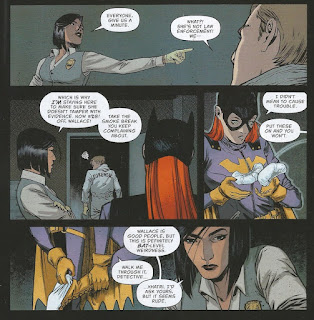






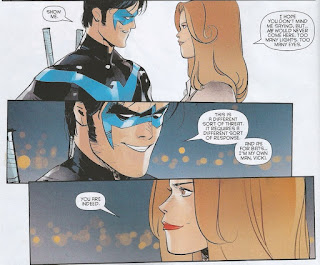

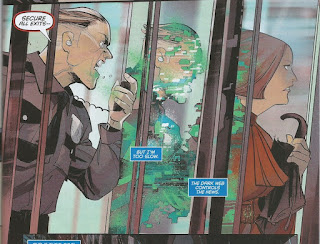

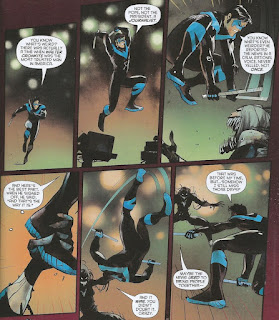







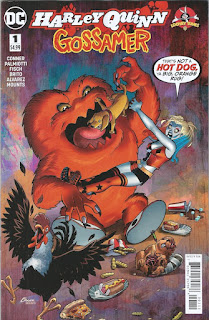




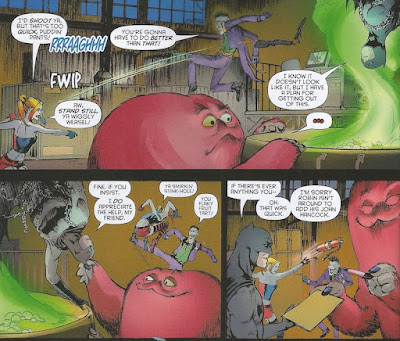




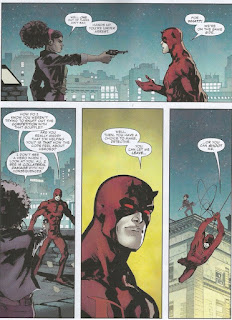








No comments:
Post a Comment